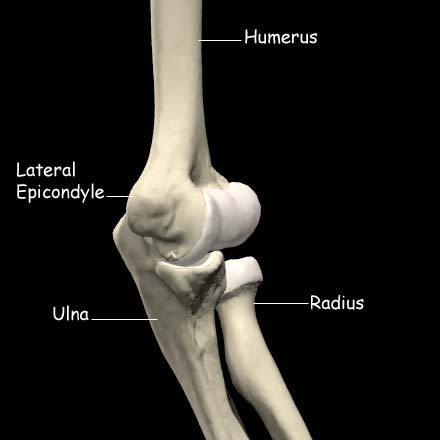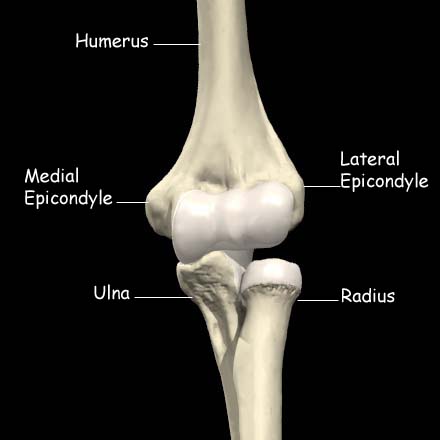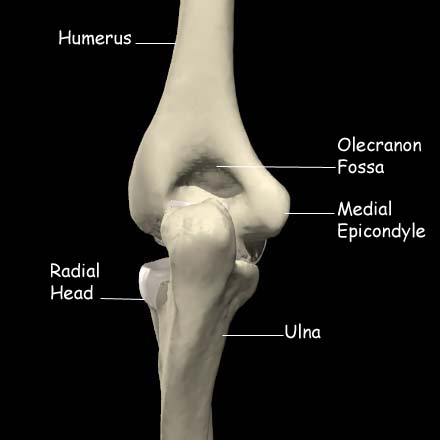Anatomy

Lateral (side view) of elbow 
Front view of elbow 
Back view of elbow
This is a painful condition affecting the elbow which is classically seen in tennis players although is common in golfers or anyone who has undertaken unaccustomed heavy manual work which involves a lot of lifting and carrying. It is caused by inflammation of the tendon of the muscles which bend the wrist backwards (the extensors).
Pain is felt over the outside of the elbow joint. A small area (the lateral epicondyle) is usually exquisitely tender. The pain may spread down into the forearm. Gripping and carrying make the pain worse, particularly if the palm is facing down (lifting papers out of briefcase)
How is the diagnosis made?
The doctor will listen to the description of events and examine the elbow. X-Rays will also be taken to determine whether there is a piece of bone involved. Usually no further investigation is needed although sometimes other investigations may be performed.
Investigations may include:
- Xray
- MRI
- Ultrasound
What is the initial treatment?
Firstly it is important to determine why the condition occurred so that recurrence may be avoided. If it is sports related the equipment or grip must be altered. Often the racquet handle is too small or too big for the hand.
The mainstay of treatment is Physiotherapy.
Exercises to improve wrist flexibility and increase the wrist flexor and extensor muscle strength must then be started as these are part of the initial problem.
A number of bands and devices are available to place round the forearm. These aim to “offload” the insertion of the extensor muscles into the lateral epicondyle. They are not a substitute for therapy but do provide symptomatic relief.
Steroid injections are used rarely as evidence has shown that, although there is good short term relief, the symptoms recur after a few months.
If initial treatment doesn’t work, what’s next?
If injections and therapy fail to settle the symptoms then surgery may be required to excise the scar tissue over the lateral epicondyle.
How can further injury be minimised?
Keep the wrist and elbow supple
Keep the flexor and extensor muscles strong
Have sports equipment checked to ensure that the grip is appropriate for the hand size
Do not suddenly increase the demands on the area (i.e. build up to sports and no sudden weekends of heavy manual labour)
Be aware of any pain, stop the activity and apply RICE.
Tennis Elbow Release
Anaesthetic
General Anaesthetic (Fully asleep)
Incisions
A 3cm is made just behind the lateral epicondyle
Procedure
The gleno-humeral (shoulder) joint will be inspected first. The damaged biceps is cut inside the joint
The common extensor origin (the site of the tennis elbow) is release from the bone. The scar tissue is removed and the tendon is reattached using a small kevlar stitch.
A video of the procedure can be found here
Wound Closure
A dissolving stitch will be used to close the wound. Small butterfly paper stitches will be used as well.
Tegaderm waterproof dressings will be placed over the top of the paper stitches.
Pain relief
Local anaesthetic will have been placed in the wound. You should wake up with no or minimal pain which should last about 6 hours. You will be prescribed painkillers to start taking when you get home and we encourage you to take these regularly for at least the first few days. There will be some discomfort but this settles quite rapidly and ice packs can be used in addition if you wish.
Wound care
The dressings will be changed before you go home and these can be left alone until they are removed. Typically they can be removed 10 days after surgery just by peeling them off and you do not need to visit the doctor for this.
The dressings are showerproof and you will be given some spares in case they start to peel off.
Rehabilitation after surgery
You will wake up with a sling on your arm. This is worn for comfort and to remind you to be careful with the arm.
- Wound care: The dressings are showerproof and you can leave them on for 10 days after which they can simply be peeled off.
- Keep moving your hand to keep your wrist from becoming stiff
Phase 2: 3-6 weeks
- You will be seen in the clinic at 3 weeks
- Formal physiotherapy will be started at this point
Surgical Risks
Every operation has an degree of risk. It is important that you are aware of these risks before you agree to proceed with your operation.
If you decide not to proceed with surgery there is a possibility that the symptoms will settle on their own but they may continue and they may get worse. You will not damage the shoulder if you decide not to proceed with surgery.
The most common or significant risks are outlined below. A risk of 0.1% means that 1 in 1000 people will suffer the complication
- Failure of the procedure to relieve symptoms: 5%
- Superficial Infection (requiring antibiotics): 0.16%
- Deep Infection (requiring further surgery): 0.02%
- PE (Pulmonary Embolus) (Blood clot in the lung): 0.13% – Blood thinning medication is required for several months. Can rarely result in death.
- DVT (Deep Vein Thrombosis) (Blood clot in the leg): 0.14% – Blood thinning medication is required for several months. Can lead to PE
- Nerve Injury: 0.01% – Usually temporary. Can cause weakness around the shoulder with loss of function and rarely can be permanent.
- Heart attack: 0.02%
- To put these numbers in perspective
The chance of:- Getting three balls in the UK national lottery: 0.9%
- Needing emergency treatment in the next year after being injured by a can, bottle, or jar: 0.1%
- Death by an accident at home: 0.01%
- For a 50 year old man in good health the 5 year risk of dying is 0.8%
Frequently asked questions
Return to work after surgery
This is very much dependent on the type of work that you do, whether you need to drive to get to work and the type of surgery that you have had done.
You, as the patient, have the best idea of the specific demands that are required of you to do your work safely and effectively.
Having an operation with an anaesthetic often takes more out of people than they would expect. Generally it is probably worth taking at least a week off from your regular work after having had any procedure.
You should discuss expected post-operative recovery and work with the surgeon before your operation.
Driving after surgery
To be able to drive safely you should be capable of actively moving your shoulder without assistance and without damaging the surgical repair. You should be able to react normally to avoid causing injury to yourself or others due to a lack of control.
Typically this is a MINIMUM 6 weeks after surgery.
It is a UK requirement that, unless specific dispensation has been granted by the DVLA, a driver uses both arms to control the steering wheel.
It is the responsibility of the driver to ensure that they are in control of the vehicle at all times. They should be able to demonstrate this if stopped by the police.
It is not a requirement to notify the DVLA unless the medical conditions likely to affect safe driving persist for longer than three months after the date of the surgery.
Drivers must not drive under the influence of narcotic medications or within a minimum of 24 hours after an anaesthetic.
You are not allowed to drive one-handed and therefore cannot drive whilst you are in the sling.
There is no precise time after surgery when you can return to driving, it varies from person to person. However, the recommended amount of time that your arm should be in a sling following surgery is the MINIMUM time before considering a return to driving.
You can return to driving when you are capable of moving your shoulder without assistance and are capable of driving safely and reacting appropriately in an emergency situation.
Although it is not essential, it may be wise to discuss your return to driving with your car insurance company.
Sports after surgery
You can start simple cardio such as walking or using a static bicycle immediately following surgery as long as you are wearing your sling.
Exercises which involve the hand or wrist cannot start until you are comfortable. This is typically about eight weeks following surgery.